- Joined
- Feb 2, 2011
- Messages
- 2,379
THE ANCIENTS
ARMIES AND ENEMIES OF ANCIENT ROME
THE SAMNITES
The Samnites and their relatives in central and south Italy are known as Oscans, from the name of their language.
The Samnites were the largest and most important Oscan nation, and was made up of a league of four tribes, the Pentri, Caudidi, Hirpini and Caraceni.

The Samnites fought a series of wars with Rome from 343 to 272, and were by far Rome’s most formidable Italian foe. Many Samnites were later to join Hannibal.
Livy the early Roman historian states that the Samnites fought in a loose phalanx formation in the form of a square, which was tactically flexible and more suited to their hilly terrain.
The Greek style phalanx was a formidable weapon especially from the front. But it was not flexible and once in contact with the enemy was vulnerable on its unprotected flanks and rear. It also need level, open terrain for its cohesion. The Romans had used the Phalanx to great effect along the coastal plains, but war in the constricted terrain of the mountainous spine of central Italy meant the Roman phalanx was a failure. The Samnites did well in mobile warfare and were well used to mountain ambushes.
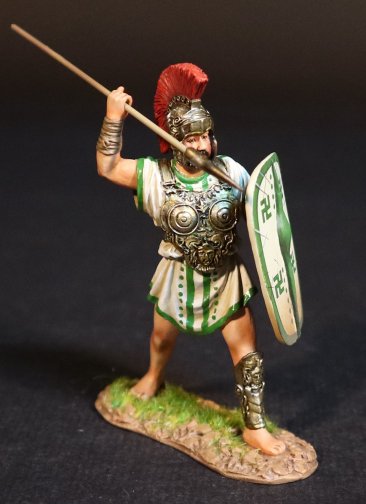
CTSM-03A
ARMIES AND ENEMIES OF ANCIENT ROME,
THE SAMNITES,
SAMNITE WARRIOR
Samnite tunics were brightly coloured and decorated, and there is little evidence of uniformity.
Their weapons included the javelin and short spear. There was a mixture of oval and round shields, and many infantry wore a distinctive cuirasse of Italian design. Small breast and backplates of leather backed bronze linked by hinged straps of similar construction passing over the shoulders and under the arms. The commonest type was the triple disc style.
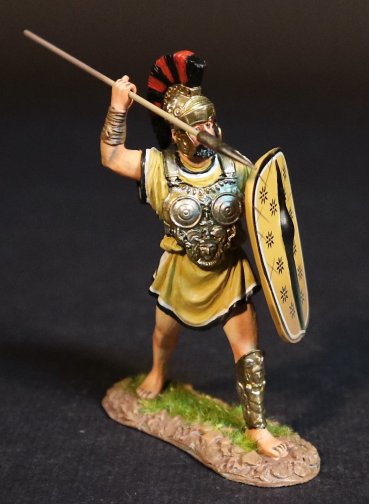
CTSM-03B
ARMIES AND ENEMIES OF ANCIENT ROME,
THE SAMNITES,
SAMNITE WARRIOR
The proportion of cavalry fielded is never mentioned in historical references, but it is assumed it was low, as the wooded mountains would not have been good cavalry country. Like the Romans the Samnite cavalry were organized into Turmae.
Many paintings show warriors carrying spears over their shoulders with bright cloths hanging from them. These are often interpreted as flags, but it is believed that they were tunics and belts. These represent trophies taken from the dead or captured enemy who had been stripped, which was a common practice in both Italy and Greece.

CTSM-03N
ARMIES AND ENEMIES OF ANCIENT ROME,
THE SAMNITES,
SAMNITE WARRIORS
ANCIENT GERMANS
Following two decades of Roman occupation, Germania Magna erupted into revolt in AD 9, resulting in the stunning loss of three Roman legions to an alliance of Germanic nations at Teutoburg. The Battle of the Teutoburg Forest, described as the Varian Disaster by Roman historians, took place in the Teutoburg Forest in 9 CE, when an alliance of Germanic tribes ambushed and decisively destroyed three Roman legions and their auxiliaries, led by Publius Quinctilius Varus.
The alliance was led by Arminius, a Germanic officer of Varus' auxilia. Arminius had acquired Roman citizenship and had received a Roman military education, which enabled him to deceive the Roman commander methodically and anticipate the Roman army's tactical responses.
Despite several successful campaigns and raids by the Romans in the years after the battle, they never again attempted to conquer the Germanic territories east of the Rhine river. The victory of the Germanic tribes against Rome's legions in the Teutoburg Forest would have far-reaching effects on the subsequent history of both the ancient Germanic peoples and the Roman Empire. Contemporary and modern historians have generally regarded Arminius' victory over Varus as "Rome's greatest defeat", one of the most decisive battles recorded in military history, and as "a turning-point in world history".
The Germanic warrior was a well trained, battle-hardened, combat ready and motivated fighter, who excelled in irregular warfare, ambushes, raids and petty warfare. In an ambush the lightly armed Germanic fighter could decisively defeat a heavily equipped legionary by using surprise and the terrain to his advantage.
These warriors were perfectly equipped for the Germanic landscape of open fields, forests and swamps. The weapons which were used included the long lance or Framea, which could be swung, thrust or thrown at an opponent.
Hair was grown long and often tied up in a figure of eight or “Suebian” knot.
In a set-piece battle the German could stand up to the Roman Legionary discipline and formations for a while, but in close quarters combat the advantage eventually shifted to the legionary.
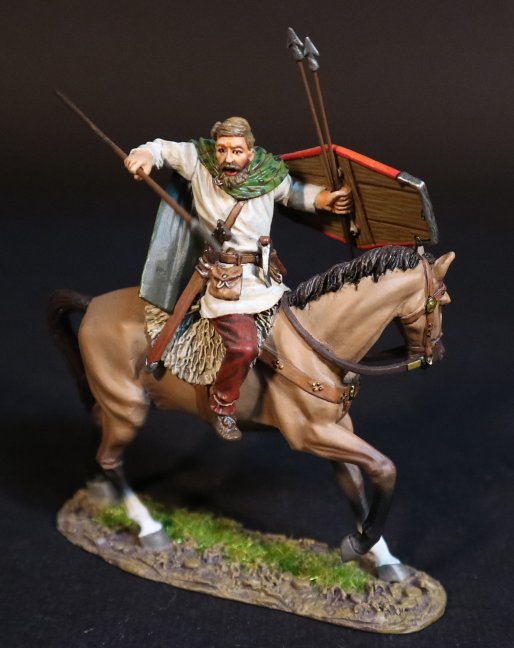
AG-20
ARMIES AND ENEMIES OF ANCIENT ROME,
GERMANIC WARRIORS,
GERMAN CAVALRY
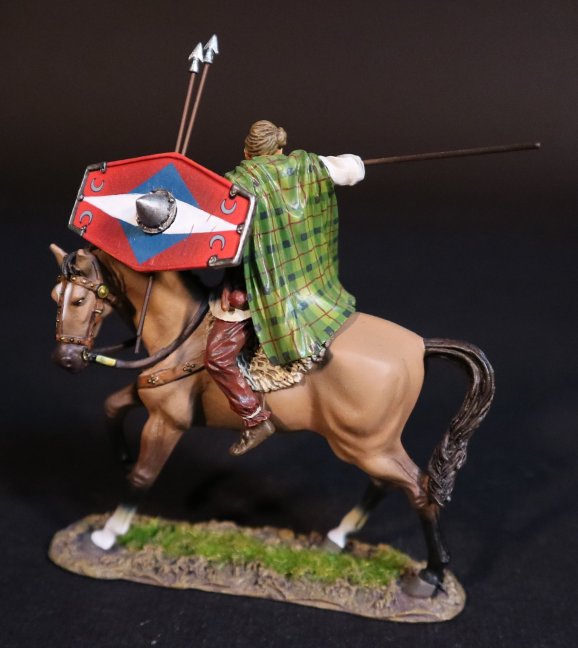
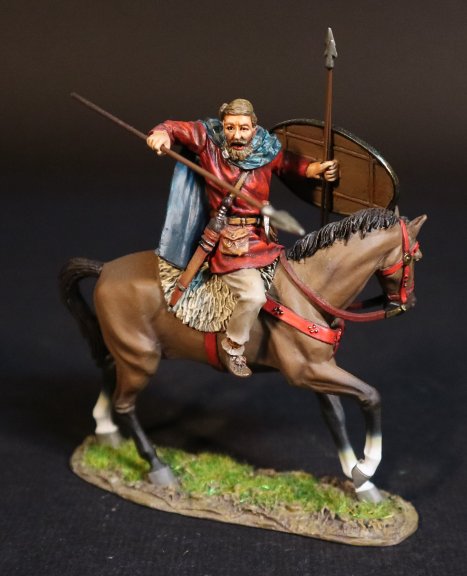
ROMCAV-20
ARMIES AND ENEMIES OF ANCIENT ROME,
CAESAR’S GERMAN CAVALRY
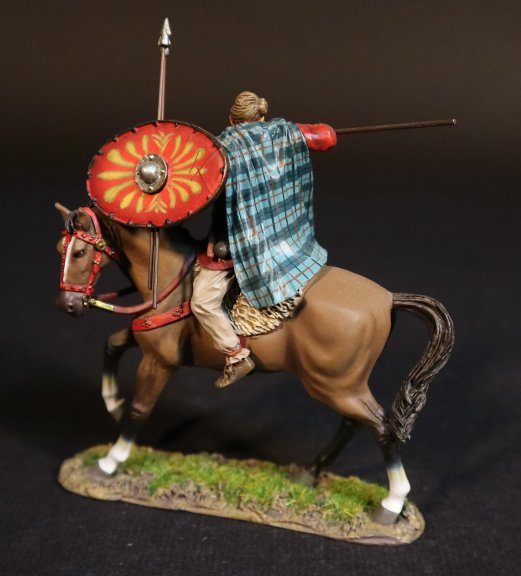
ROMAN AUXILLIARY CAVALRY
As Romans were never considered exceptionally good horsemen, and the role of the cavalry not as important in the Roman thought process, the Equitatus was generally made up of non-Roman horsemen. While they would play an important part of Legionary tactics, the Roman Cavalry was considered secondary and would remain the weakest part of the Roman Army until the very late Imperial period.
Generally, the cavalry was used as light skirmishing troops, and mounted archers whose job was to patrol, act as scouts and messengers and to provide a mobile defensive screen while the legion was massing in battle array. As in all armies throughout history, the mounted trooper was also very effective in chasing down and harassing a fleeing and panicked enemy force.
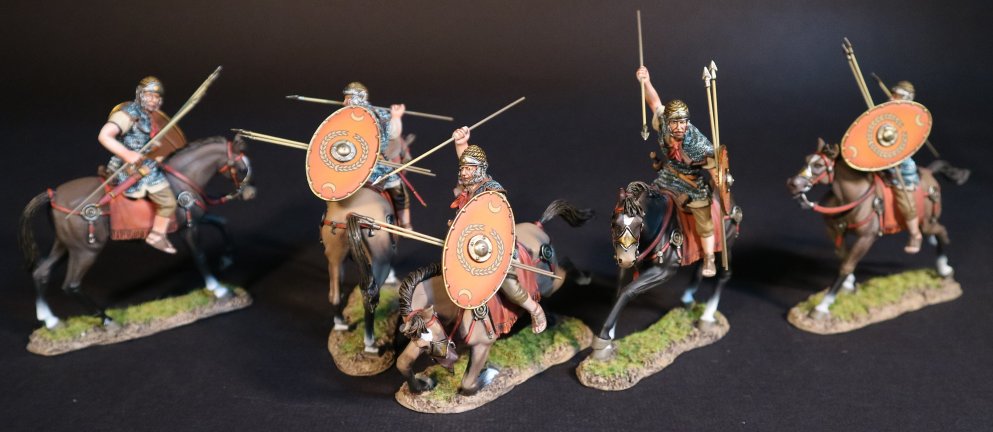
As part of the military reforms of Augustus around AD 14, the Auxilia were re-organized. They would be trained to the same standards of discipline as the legions. They were mainly drawn from a wide range of warlike peoples throughout the provinces, and would receive Roman citizenship on completion of their 25 year service. Senior officers in contrast were Roman citizens.
The Auxilia filled the tasks of patrolling, containing raids, tax collecting, and the multitude of duties of the frontier troops.
They were especially suited to garrison and local policing activities, and could also hold their own in small scale warfare.
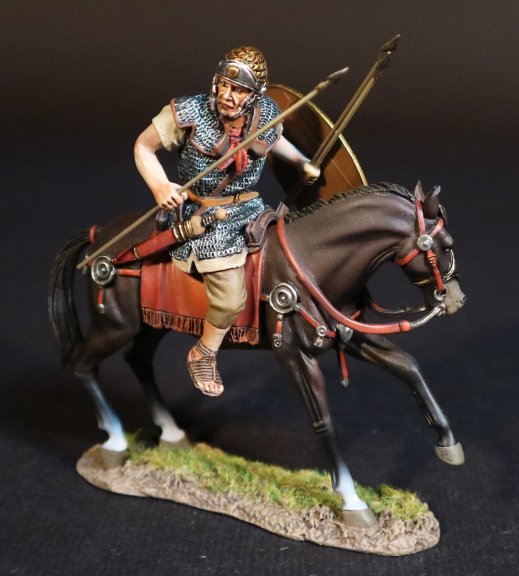
ROMCAV-14A
ARMIES AND ENEMIES OF ANCIENT ROME,
ROMAN AUXILIARY CAVALRY
Roman Auxilia cavalry were usually heavily armored in mail and armed with a short lance, javelins, the Spatha long sword, and sometimes bows for specialist Horse archer units. These men primarily served as Medium missile cavalry for flanking, scouting, skirmish, and pursuit
Cavalry units were known as Alae, and were made up of 16 Turmae.
A Turmae consisted of 30 troopers, and was commanded by a Decurio, and a second in command called the Duplicarius.
Cavalrymen carried Clipeus , a flat oval or hexagonal shield. These were extremely light, constructed of double or triple thickness plywood, made up of thin strips of birch.
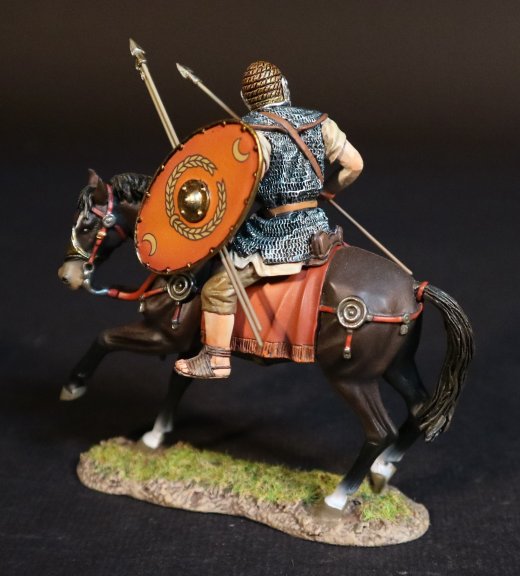
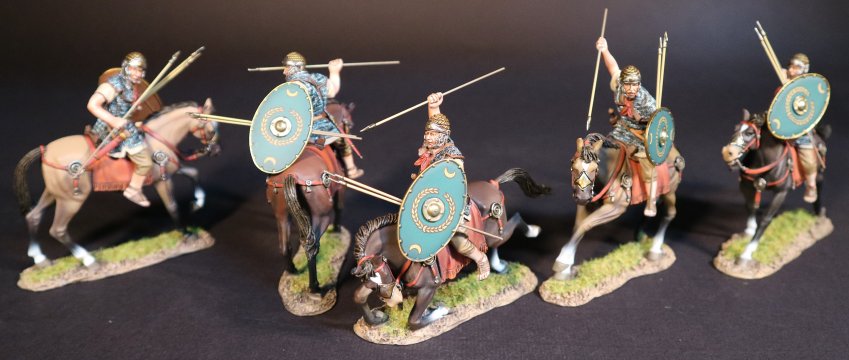
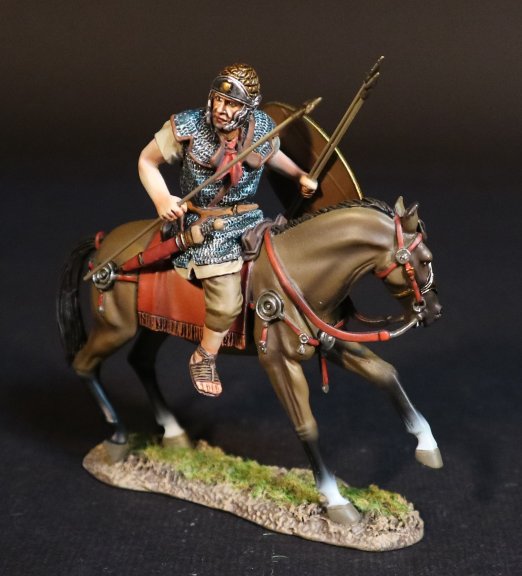
ROMCAV-14B
ARMIES AND ENEMIES OF ANCIENT ROME,
ROMAN AUXILIARY CAVALRY
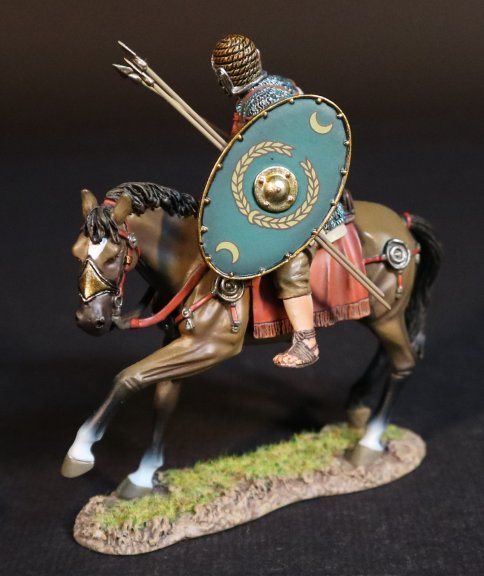
Contact your Dealer to Pre-Order today!
ARMIES AND ENEMIES OF ANCIENT ROME
THE SAMNITES
The Samnites and their relatives in central and south Italy are known as Oscans, from the name of their language.
The Samnites were the largest and most important Oscan nation, and was made up of a league of four tribes, the Pentri, Caudidi, Hirpini and Caraceni.

The Samnites fought a series of wars with Rome from 343 to 272, and were by far Rome’s most formidable Italian foe. Many Samnites were later to join Hannibal.
Livy the early Roman historian states that the Samnites fought in a loose phalanx formation in the form of a square, which was tactically flexible and more suited to their hilly terrain.
The Greek style phalanx was a formidable weapon especially from the front. But it was not flexible and once in contact with the enemy was vulnerable on its unprotected flanks and rear. It also need level, open terrain for its cohesion. The Romans had used the Phalanx to great effect along the coastal plains, but war in the constricted terrain of the mountainous spine of central Italy meant the Roman phalanx was a failure. The Samnites did well in mobile warfare and were well used to mountain ambushes.

CTSM-03A
ARMIES AND ENEMIES OF ANCIENT ROME,
THE SAMNITES,
SAMNITE WARRIOR
Samnite tunics were brightly coloured and decorated, and there is little evidence of uniformity.
Their weapons included the javelin and short spear. There was a mixture of oval and round shields, and many infantry wore a distinctive cuirasse of Italian design. Small breast and backplates of leather backed bronze linked by hinged straps of similar construction passing over the shoulders and under the arms. The commonest type was the triple disc style.

CTSM-03B
ARMIES AND ENEMIES OF ANCIENT ROME,
THE SAMNITES,
SAMNITE WARRIOR
The proportion of cavalry fielded is never mentioned in historical references, but it is assumed it was low, as the wooded mountains would not have been good cavalry country. Like the Romans the Samnite cavalry were organized into Turmae.
Many paintings show warriors carrying spears over their shoulders with bright cloths hanging from them. These are often interpreted as flags, but it is believed that they were tunics and belts. These represent trophies taken from the dead or captured enemy who had been stripped, which was a common practice in both Italy and Greece.

CTSM-03N
ARMIES AND ENEMIES OF ANCIENT ROME,
THE SAMNITES,
SAMNITE WARRIORS
ANCIENT GERMANS
Following two decades of Roman occupation, Germania Magna erupted into revolt in AD 9, resulting in the stunning loss of three Roman legions to an alliance of Germanic nations at Teutoburg. The Battle of the Teutoburg Forest, described as the Varian Disaster by Roman historians, took place in the Teutoburg Forest in 9 CE, when an alliance of Germanic tribes ambushed and decisively destroyed three Roman legions and their auxiliaries, led by Publius Quinctilius Varus.
The alliance was led by Arminius, a Germanic officer of Varus' auxilia. Arminius had acquired Roman citizenship and had received a Roman military education, which enabled him to deceive the Roman commander methodically and anticipate the Roman army's tactical responses.
Despite several successful campaigns and raids by the Romans in the years after the battle, they never again attempted to conquer the Germanic territories east of the Rhine river. The victory of the Germanic tribes against Rome's legions in the Teutoburg Forest would have far-reaching effects on the subsequent history of both the ancient Germanic peoples and the Roman Empire. Contemporary and modern historians have generally regarded Arminius' victory over Varus as "Rome's greatest defeat", one of the most decisive battles recorded in military history, and as "a turning-point in world history".
The Germanic warrior was a well trained, battle-hardened, combat ready and motivated fighter, who excelled in irregular warfare, ambushes, raids and petty warfare. In an ambush the lightly armed Germanic fighter could decisively defeat a heavily equipped legionary by using surprise and the terrain to his advantage.
These warriors were perfectly equipped for the Germanic landscape of open fields, forests and swamps. The weapons which were used included the long lance or Framea, which could be swung, thrust or thrown at an opponent.
Hair was grown long and often tied up in a figure of eight or “Suebian” knot.
In a set-piece battle the German could stand up to the Roman Legionary discipline and formations for a while, but in close quarters combat the advantage eventually shifted to the legionary.

AG-20
ARMIES AND ENEMIES OF ANCIENT ROME,
GERMANIC WARRIORS,
GERMAN CAVALRY


ROMCAV-20
ARMIES AND ENEMIES OF ANCIENT ROME,
CAESAR’S GERMAN CAVALRY

ROMAN AUXILLIARY CAVALRY
As Romans were never considered exceptionally good horsemen, and the role of the cavalry not as important in the Roman thought process, the Equitatus was generally made up of non-Roman horsemen. While they would play an important part of Legionary tactics, the Roman Cavalry was considered secondary and would remain the weakest part of the Roman Army until the very late Imperial period.
Generally, the cavalry was used as light skirmishing troops, and mounted archers whose job was to patrol, act as scouts and messengers and to provide a mobile defensive screen while the legion was massing in battle array. As in all armies throughout history, the mounted trooper was also very effective in chasing down and harassing a fleeing and panicked enemy force.

As part of the military reforms of Augustus around AD 14, the Auxilia were re-organized. They would be trained to the same standards of discipline as the legions. They were mainly drawn from a wide range of warlike peoples throughout the provinces, and would receive Roman citizenship on completion of their 25 year service. Senior officers in contrast were Roman citizens.
The Auxilia filled the tasks of patrolling, containing raids, tax collecting, and the multitude of duties of the frontier troops.
They were especially suited to garrison and local policing activities, and could also hold their own in small scale warfare.

ROMCAV-14A
ARMIES AND ENEMIES OF ANCIENT ROME,
ROMAN AUXILIARY CAVALRY
Roman Auxilia cavalry were usually heavily armored in mail and armed with a short lance, javelins, the Spatha long sword, and sometimes bows for specialist Horse archer units. These men primarily served as Medium missile cavalry for flanking, scouting, skirmish, and pursuit
Cavalry units were known as Alae, and were made up of 16 Turmae.
A Turmae consisted of 30 troopers, and was commanded by a Decurio, and a second in command called the Duplicarius.
Cavalrymen carried Clipeus , a flat oval or hexagonal shield. These were extremely light, constructed of double or triple thickness plywood, made up of thin strips of birch.



ROMCAV-14B
ARMIES AND ENEMIES OF ANCIENT ROME,
ROMAN AUXILIARY CAVALRY

Contact your Dealer to Pre-Order today!

